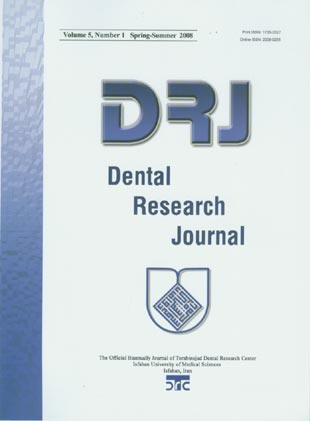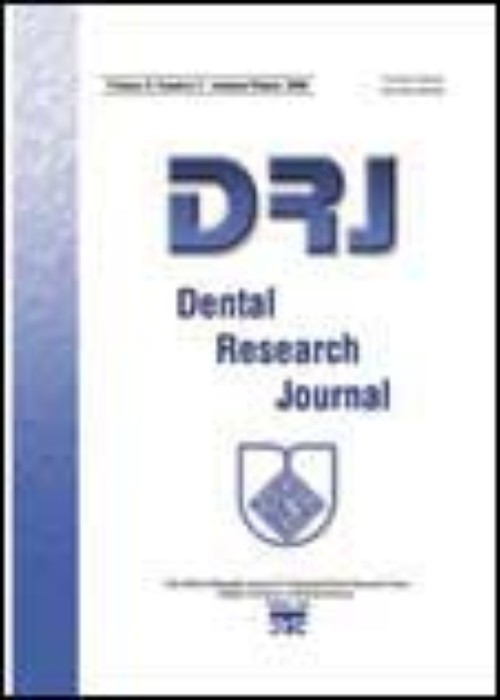فهرست مطالب

Dental Research Journal
Volume:5 Issue: 1, Jan 2008
- تاریخ انتشار: 1387/02/11
- تعداد عناوین: 9
-
Page 1Gingival recession refers to apical migration of the gingival margin. Smoking is one of the most important risk factors for periodontitis that affects the prevalence, extent and severity of disease. The aim of this study was to assess the effects of smoking on gingival recession.
Fifty smokers and 55 non-smokers took part in this cross-sectional study. Gingival recession on buccal and palatal surfaces of all teeth was measured. In addition, the relationship between the gingival recession and the following factors was evaluated: educational level, age, number of cigarettes used per day, plaque control methods, the age at which smoking started and plaque index. The data were analyzed using t-test and the coefficient of correlation.
According to data analysis, the smoker subjects had a significantly greater mean recession than non-smokers. There was a positive relationship between gingival recession and the number of cigarettes used per day, duration of use and plaque index. There was a negative significant relationship between gingival recession and plaque control method, as well as educational level.
The results of this study indicated that smoking causes gingival recession, possibly via alteration in immune response and topical changes such as decreasing gingival circulation.Keywords: Gingival recession, periodontitis, smoking -
Page 5In the periodontium, the functions of the cell populations regarding the host-mediated tissue destruction in health and disease are not well understood. The purpose of this study was to measure the expression of genes differentially expressed in chronically inflamed periodontal ligament (PDL) cells compared to healthy PDL cells.
We compared the genome-wide gene expressions of chronically inflamed and healthy PDL cells by microarray analysis, and validated the data by real-time RT-PCR to identify the genes that might play distinct roles in chronic periodontal disease in vivo.
The expression rates of 14,239 genes were investigated and 3,165 of them were found differentially expressed by at least two-fold; the expression rates of 1,515 genes were significantly upregulated and the expression rates of 1,650 genes were significantly downregulated in inflamed PDL cells.
We focused on mainly structural components, for example, laminins and integrins, as well as degrading enzymes, for example, MMPs and cathepsins. The molecular composition of the laminin network varies in chronically inflamed compared to healthy PDL cells in vivo. Furthermore, integrin alpha6beta4, together with laminin-332, might be involved in chronic periodontal inflammation. Diverse keratins were upregulated, indicating that the epithelial cell rests of Malassez might also be involved in chronic periodontitis. The microarray analysis has identified a profile of genes potentially involved in chronic periodontal inflammation in vivo.Keywords: Extracellular matrix, inflammation, microarray analysis, periodontal ligament -
Page 13Tooth discoloration has different etiologic factors, many of which can be prevented. The exact mode of inheritance has been clearly established in only a few of these conditions. The aim of this study was to determine the prevalence and etiology of tooth discoloration in female teenage students of Isfahan.
In this cross-sectional study, 384 female students were examined for tooth discoloration. The examination was conducted by explorer and mirror. The information was recorded and analyzed by an SPSS program.
Relative frequency for etiologic factors of tooth discoloration consisted of caries 71.1%, extrinsic stains 24.7%, hypoplasia 19.8%, root and crown filling materials 19.8%, trauma 0.8%, chlorhexidine mouth wash 0.3% and fluorosis 0.3%.
Dental caries were the most common cause of tooth discoloration, according to the results of this study. It is important, therefore, to search for the agents that are responsible for producing such a high prevalence of dental caries. This requires careful analysis of oral hygiene and other nutritional attributes of all foods and drinks.Keywords: Dental caries, dental fluorosis, stains, tooth discoloration -
Page 17The aim of this study was to determine whether beta-thalassemia major is associated with an increased risk of periodontal disease, dental caries and malocclusion.
In this cross-sectional study, 50 patients (21 males and 29 females) with thalassemia major, between two and 20 years of age, and 50 healthy matched control individuals, were included. Demographic, hematological and odontostomatological data (hematological picture, the face characteristics and odontostomatologic examination) were collected for each patient. Patients and control individuals were examined for plaque deposits, gingivitis, periodontitis and dental caries using Silness and Loe plaque index (Pl.I), Loe and Silness gingival index (GI), probing pocket depth (PPD) and decayed, missing and filled teeth (DMFT) respectively and also were evaluated for malocclusion. Data were analyzed by t-student and Mann-Whitney tests.
0.05). Dental caries were significantly higher in thalassemic patients (P < 0.001) in comparison with the healthy control group. Various and serious malocclusion stages (Angle''s II class, deep bite and open bite) were seen especially in older patients.
Thalassemia is not associated with increased rates of gingivitis or periodontitis, but it is associated with higher rates of dental caries and malocclusion.Keywords: Dental caries, malocclusion, periodontal diseases, thalassemia -
Page 21When composite resin polymerizes, shrinkage stresses tend to produce gaps at the tooth restoration interfaces. The aim of this study was to assess the ability of two low viscosity resin systems (Single Bond, and Prompt L-Pop) and a specific surface penetrating (PermaSeal) sealant in preventing microleakage in class V composite restorations.
Hundred and five caries free human premolars were selected. Wedge shaped cavities with occlusal margins in enamel and cervical margins in dentin were prepared and restored using Single Bond and Z100 composite resin. After storing the samples in distilled water for 24 hours, finishing and polishing was done and then they were randomly divided into six groups each including 15 samples along with one control group. Other groups were sealed using three different agents with and without etched margins. The specimens were thermocycled and then, immersed in a 50% silver nitrate solution as tracer agent for 4 hours. All samples sectioned longitudinally and analyzed for leakage (dye penetration) using a stereomicroscope. Kruskal-Wallis and Mann Whitney U tests were used for statistical analysis.
Kruskal-Wallis test showed significant differences between the groups. Mann-Whitney U analysis revealed significant reduction in microleakage only in two groups namely, PermaSeal with etched and Prompt L-Pop without etched margins. There was no evidence of microleakage at the occlusal margins in any group.
The results obtained in this in vitro study showed that applying PermaSeal with etched and Prompt L-Pop without etched margins could reduce marginal leakage and improve marginal integrity.Keywords: Composite resins, dental bonding, leakage -
Page 27It is of great importance for clinicians to have confidence in the accuracy of an electronic apex locator in the presence of an irrigant. The purpose of this study was to evaluate the effect of different irrigation solutions on the accuracy of the Raypex5 electronic apex locator.
In this experimental in vitro study, 20 straight and single canals of extracted maxillary central teeth were used. Access cavities were prepared and actual working length was determined. Electronic working length by means of Raypex5 apex locator was measured in the presence of saline, 0.2% chlorhexidine, and 5.25% sodium hypochlorite. Data were analyzed by ANOVA with repeated measurements.
There was no significant difference between actual and electronic working length in the presence of different solutions (P = 0.533).
Under the conditions of the present study, the accuracy of the Raypex5 was in an acceptable range in the presence of different irrigating solutions.Keywords: Electronic apex locator, irrigation, root canal therapy -
Page 31Treating caries-susceptible pits and fissures with resin sealants enjoys wide acceptance as a preventive strategy. The aim of this study was to evaluate the one-year clinical performance of a polyacid-modified resin composite material (Dyract) in comparison to a composite resin material (Helioseal F).
Using a half-mouth design, 100 sealants were placed on the sound first permanent molars of 50 children aged between six and 10 years. Half of the teeth (n = 50) were sealed with Dyract and half (n = 50) with Helioseal F. Teeth were evaluated at baseline, 3, 6 and 12 month intervals. The qualities of the restorations were evaluated in accordance with modified U.S. Public Health Service (USPHS) codes and WHO criteria for the presence of dental caries. The data were analyzed according to the Mann-Whitney test and the spearman correlation.
0.05). Decayed/Missing/Filled Teeth index (DMFT) had convert relation with retention and marginal integrity in both materials.
In this study there was no clinical difference between the two sealants. Polyacid Modified Resin Composite (PMRC) materials have low wear resistance compared to resin composite, but the two curing reactions that occur in PMRC materials might have improved their mechanical retention in the long term. Therefore, further study on these characteristics is recommended.Keywords: Composite resins, compomers, pit and fissure sealants, retention -
Page 37Careful preoperative treatment planning, augmentation of hard and soft tissues, and attention to the details of implant surgical and prosthetic techniques are areas that must be addressed when treating the anterior maxilla. This report addresses the fundamental considerations related to replacement of congenitally missing lateral incisors by a team approach.Keywords: Implant, incisor, orthodontics
-
Page 41Hyperparathyroidism (HPT) is a disease, which results from increased secretion of parathyroid hormone(PTH). Primary HPT results from autonomous hyperplasia or a tumor in parathyroid and secondaryHPT is usually associated with decreased calcium level due to chronic renal disease. Browntumors have been seen occasionally at the terminal stages of HPT. A case of 19-year-old man withhistory of end-stage renal disease (ESRD) demonstrating two expansive lesions in jaws is reportedhere. PTH and alkaline phosphatase (ALP) were extremely high and consequently, a diagnosis of
secondary HPT was established. Contrary to the typical secondary HPT, the patient was normocalcemic.Computed tomography scan showed mixed radiolucent-radioopaque pattern of lesions andossifications were significant. Surgical excision was carried out and histology revealed presence offibro-endothelial connective tissue with broad areas of osteoids and numerous multinucleated giantcells, as seen in cases of brown tumors.Keywords: Alkaline phosphatase, brown tumors, hyperparathyroidism


